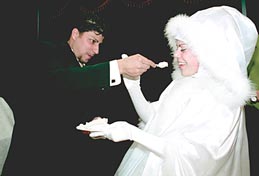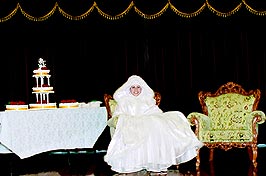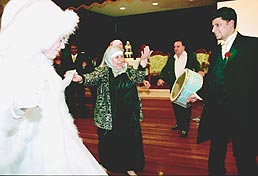
|
| Sharing the wedding cake |
Rema & Fadle
Author: Mary Ann Hamilton, Getting Married project
Getting Married: Rema el Hassan and Fadle el Harris, two young Australians of Lebanese Muslim heritage, were brought together in the traditional way. They married in September 2001 in the formal Islamic marriage ceremony, nikah. A year later they marked the beginning of their life together in a celebration that joyfully combined elements of traditional Lebanese, Islamic and the western wedding traditions.
An Islamic wedding ceremony
Lakemba, September 2001
A quartet of drummers fronted by an accomplished male singer sets the mood for the celebration of Rema and Fadle's nikah, or marriage ceremony. The group performs a lively suite of Arabic songs to the gathering of the couple's friends and family. After a time the singer fetches two of the traditional sticks to dance the traditional raqs al asaya or combat dance for the guests. He twirls his sticks and dances, turning this way and that, engaging audience members and then Fadle himself in a playful faux stick fight.
An agreement struck by two families
When all the guests have arrived the sheikh (Muslim spiritual leader), Fadle's father and a male relative of Rema's sit at a table at the front of the hall which has been hired for the event. There, they prepare for the afternoon's formalities. This is a low-key affair. The hall is scantly decorated and there is little pomp and ceremony to detract from the central purpose of the occasion; the marriage of a young couple witnessed by their community. In Rema and Fadle's case, the festivities will take place a year later, when they throw a large party to celebrate their marriage.
Nikah – Islamic marriage ceremony
During the nikah, the marriage contract (nikah-nama) is finalised, an offer of marriage made and accepted (ijab-e-qubul), and a wedding gift or mahr is agreed for the bride. An Islamic marriage does not have to be celebrated by an Imam or priest, but must be made in the presence of at least two witnesses, and usually takes place in the company of family and friends.
Once these arrangements are finalised the couple are married under Islamic law. They are then able to meet without supervision. If they chose to do so at this time the couple are able to live together according to Islam.
Mahr – a marriage gift or dowry for the bride
Fadle joins the men at the table as his father and Rema's relatives begin to agree on the marriage contract and settle on the dowry. The pledge of mahr or a dowry dates back to the time of the prophet Muhammad.
 |
 |
|
(Rema) When the Imam Ali came to marry Fatima, Muhammad's daughter,
he had only his sword, his armour and his camel which he sold to raise
the money for her dowry.
|
The dowry was usually an amount of gold, but these days it is made in money or goods. It is pledged to the bride to prove that the groom is fit to marry her, and can look after her properly. If the groom dies or instigates a divorce, the dowry is meant to provide for his wife.
Ijab-e-Qubul – a formal offer and acceptance of marriage
The offer of marriage is made by Fadle's father and accepted by Rema's relative. Rema now joins the group. She sits beside Fadle and they listen closely to the verses from the Qur'an describing the responsibilities of both partners: "The man has been advised in Islam he must look after his wife, must guide her, protect her, provide her food, shelter, clothes, make her comfortable in her life' The woman has been advised in Islam that she must keep herself for her husband and cherish and honour him' In the name of Allah, creator of all mankind'we give Allah thanks that in his wisdom and grace these two have found affection and love'".
Fadle and Rema accept each other in marriage in front of their guests and sign their marriage certificates. The room erupts in clapping and trills from the women as the couple become husband and wife under Islamic and Australian law.
A new level of relationship
Although they are now married and their relationship
is accepted in the eyes of their community, Fadle and Rema have decided they
will not to live together just yet. Their wedding celebration planned for July
2002 – a large party for family and friends – will mark the beginning
of their life together as husband and wife.
Getting together
An arranged meeting
Fadle and Rema were initially brought together by Fadle's mother, in a traditional way. Mrs el Harris first saw Rema at the mosque as they went to pray one morning. After a chance meeting a couple of weeks later, Mrs el Harris was convinced that Rema was a girl with many good qualities. She felt that it would be good to introduce Rema to her son with a view to marriage. She rang Rema's mother and they arranged a time for the young people to meet under the watchful eye of Rema's family.
 |
 |
|
At this stage I had not even thought of marriage – I just
wanted to finish my studies and get a job and maybe find Mr Right in about
10 years' time!!.
|
How to find Mr and Ms Right
When Rema was young she had very definite ideas that arranged introductions were not her style. She thought they were not a good way of going about finding a soul mate. She was determined that when she decided it was time to marry she would find her Mr Right somewhere on her own. As she grew older, though, these ideas changed, and she began to value the security and support inherent in the way Islam recommended that men and women find their life partners.
 |
 |
|
I realised that I was lucky because in Islam if you are looking
for marriage, all you have to do is to get your parents to announce it
without any shame... No one is forced into marriage... The parents connect
the two children together... I enjoyed getting to know Fadle through an
arranged introduction because everyone knew what was going on, everything
was above board, and besides, my mother is pretty cool, she's not too
strict for a 60 year old woman born in Lebanon.
|

Waiting for the groom
Fadle was 24 years old. He had completed art school where he had socialised widely and made many good friends outside his Lebanese Muslim community. He had not really thought about marriage when his parents suggested that he take the time to meet some young women in the way traditional to Islam. He was introduced to a couple of young women, and while they were lovely people, he did not feel in his heart that they were right person to spend the rest of his life with.
At this stage Fadle would have been content to put off the whole issue of marriage and concentrate on the comparatively easier task of establishing his independent media production company.
 |
 |
|
(Fadle) Anyway, one day my mother said 'You've got to meet this
girl'. I said 'I don't want to – I'm sick of being taken to meet
girls'. She insisted and I said 'This is the last one – after this
I am not seeing any more girls for a while at least! ''. The first thing
I noticed were her eyes – they were so attractive. I said to myself
'hang on, let's see what's inside'. So we talked and she seemed well spoken,
well mannered and modest. I saw her again'and again, and the more I saw
her the more I liked her.
|
 |
 |
|
When we first met I immediately thought ‘Wow!'. It had
nothing to do with his looks, I just got a really good feeling from him…
Ever since we have been together and I don't think anything can take us
apart except death.
|
Getting to know each other
And so Fadle and Rema began their relationship in the customary way
of a young Muslim couple.
 |
 |
|
Our parents just assumed that we would be getting married when
we started spending so much time together. In Islam you are not supposed
to have a boyfriend or a girlfriend – a relationship is for marriage.
|
Even though she is only young, Rema had also had occasion to think carefully
about the issue of establishing relationships, and what that would mean for
her life. At work she had been approached by a boy who asked her out. She had
considered seeing him, but decided against it.”
 |
 |
|
I said ‘no, I'm sorry, I'm looking for long term commitment,
not just being girlfriend and boyfriend'.
|
And so, in a very short time, and with the support and approval of their families
and community, Rema and Fadle grew very close. They discussed the possibility
of taking their relationship one step further, preparing for marriage under
Islamic law. Fadle and Rema refer to this event as their engagement.”
A year after nikah – the party
Rema and Fadle's celebration
It is July 2002, one year after the nikah ceremony, and Fadle and Rema
are about to celebrate their wedding party in preparation for finally moving
in together.
Fadle's day gets off to a late start. He is late getting up and late
collecting Rema. The sun is setting in a glow of orange and pink when they have
their wedding portraits taken at La Perouse. Rema grins and Fadle looks proudly
into the camera, ready for anything.
A Lebanese-style wedding party
Rema is in the waiting room trying to calm her nerves. Numerous small
relatives hover around her asking questions and just admiring Rema all dressed
up in her wedding gown.

Rema's mother joins the couple
She does look very glamorous in her white Cinderella style-wedding dress –
a full skirt of white tulle and fitted satin bodice. Over the dress is a large
white satin cloak trimmed with white fur. The cloak covers her head, neck, arms
and shoulders. It allows Rema to maintain hijab, the code of modest
dress worn by many Muslim women, while fulfilling her dream of a big white wedding
dress! She wears long white gloves and holds a bouquet of deep red roses.
The reception hall is full. Family groups fill the tables and groups of teenage
girls and boys chat and look around for signs that the wedding party is about
to begin. At the front of the hall the stage is decorated with a sumptuous backdrop
of velvet curtains, the wedding cake and two ornate armchairs.
A drum beats out and the wedding procession starts as Fadle's parents,
Mustafa and Hana el Harris, make their way to the front of the hall followed
by Rema's parents, Mr and Mrs el Hassan, and the rest of the immediate
family. The last to enter, amid joyful clapping and trilling, are Fadle and
Rema, followed closely by the Arabic drummer playing a large tabl,
an Arabic double-sided drum played with the hand and a beater.
The couple formally walk past family members and guests three times to the
strains of the drum and mismar, an Arabic wind instrument, and finally,
they begin to dance together. The mothers and then the other family members
join them as the wedding guests watch.
The women celebrate privately
The formal dance finishes and there is a flurry of activity as the women impatiently
wave the men out of the hall and the glass doors at the entrance are covered
with lengths of material.
 |
 |
|
Islam forbids men and women dancing together. But we are allowed
to dance and celebrate at all-ladies' or all-men's events. My mum and
her friends love dancing so I decided to give them a ladies' party to
say thanks.
|
When the men have gone there is an exodus of the women to the ladies'
room where head scarves and coats are shed. The women re-emerge wearing their
very best dancing clothes.
 |
 |
|
Lebanese women love their clothes – we love strutting
around in beautiful dresses.
|
The women's party that Fadle has promised his mother is about to begin.
Tradition and innovation
While the marriage ceremony, nikah, is celebrated in a prescribed Islamic
tradition, Rema and Fadle's wedding celebration, like that of many young
Lebanese couples, has been a creation of their own making. It has combined Arabic
and Muslim tradition with elements of western celebrations. Holding separate
men's and women's parties comes from a long tradition of celebration
in the Middle East. Rema's glamorous white wedding dress and the tiered
wedding cake lie firmly in the western tradition.The gift of a ring is shared
between both traditions.
Other customs surrounding the wedding of a young couple have been reluctantly
omitted in the Australian context.
 |
 |
|
In the village where my mother grew up they would stick a piece
of dough on the front door of the bride's parents' house on the day she
was to leave to live with her husband. Family, friends and neighbours
then attached coins and notes to the dough as a gesture of well wishes.
So you could always tell where a bride was living because you could see
the dough and money.
|
In other parts of Lebanon it is customary for the father of the groom to trim
his son's beard and to groom his hair on the day of the wedding.

The parents' story
Hana and Mustafa had a traditional wedding in Lebanon in 1975.
>> Read their story
Final formalities
At around 10 pm, after a couple of hours of dancing, the women resume hijab
and the men return to the wedding party. Fadle screens a video of images of
them both as they have grown from childhood to adulthood and then the wedding
cake is cut. There are speeches from various family members and finally Fadle
and Rema formally thank all those present for sharing their happiness. Fadle
then presents Rema with a wedding ring.
Life together
For the 12 months between the nikah and the wedding party, Fadle and
Rema lived with their own families. But they were able to spend time in each
other's company and extend the first gestures of affection into a close and
loving relationship. On a more practical level, they planned to spend the year
saving to buy and renovate a flat that was to become their home.
After the wedding party celebrations Fadle and Rema began their life together
in their own home. They have adapted happily to their shared life, and in August
2003 they celebrated the birth of their first child.
> Take a look at some more weddings
|





